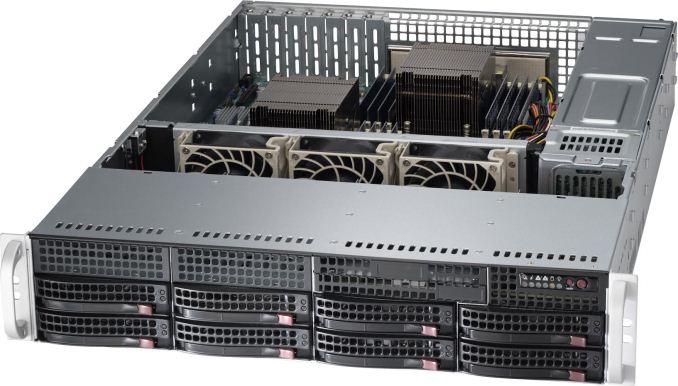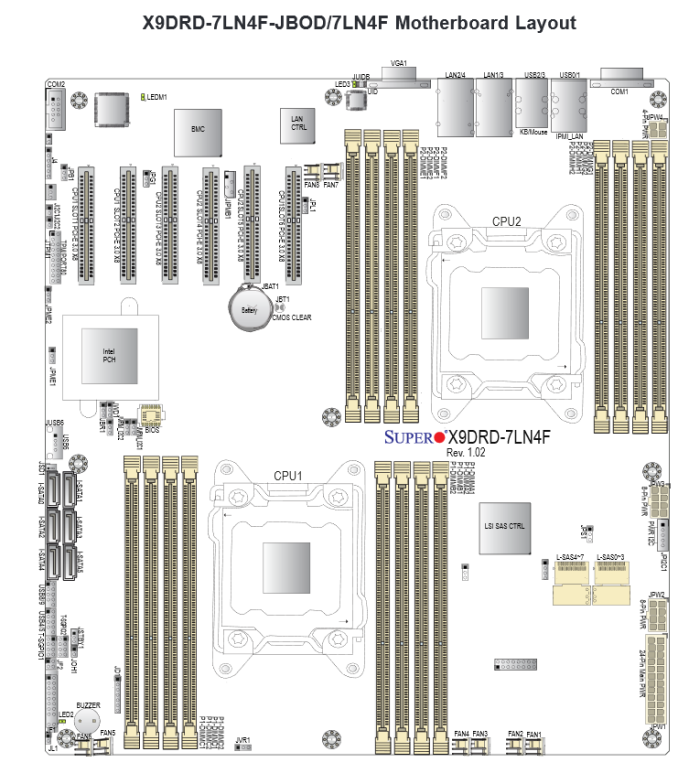Free Cooling: the Server Side of the Story
by Johan De Gelas on February 11, 2014 7:00 AM EST- Posted in
- Cloud Computing
- IT Computing
- Intel
- Xeon
- Ivy Bridge EP
- Supermicro
The Supermicro "PUE-Optimized" Server
We tested the Supermicro Superserver 6027R-73DARF. We chose this particular server for two main reasons: first, it is a 2U rackmount server (larger fans, better airflow) and secondly, it was the only PUE optimized server with 16 DIMMs. Many applications are more memory capacity than CPU limited, so a 16 DIMM server is more desirable to most of our readers than an 8 DIMM server.
On the outside, it looks like most other Supermicro servers, with the exception that the upper third of the front is left open for better airflow. This in contrast with some Supermicro servers where the upper third is filled with disk bays.
This superserver has a few features to ensure that it can can cope with higher temperatures without a huge increase in energy consumption. First of all, it has an 80 Plus Platinum power supply. A platinum PSU is not exceptional anymore: almost every server vendors offers at least the slightly less efficient 80 Plus Gold PSUs. Platinum PSUs are the standard for new servers, DELL and Supermicro even started offering 80 Plus Titanium PSUs (230V).
Nevertheless, these Platinum PSUs are pretty impressive: they offer better than 92% efficiency from 20% to 100% load.
Secondly, it uses a spreadcore design. Here, the CPU heatsinks do no obstruct each other: the air flow will go over them in parallel.
Three heavy duty fans blow over a relatively simple motherboard design. Notice that even the heatsink on the 8W Intel PCH (602J chipset) is also in parallel with the CPU heatsinks. Indeed, the PCH heatsink will get an unhindered airflow. Last but not least, these servers come with specially designed air shrouds for maximum cooling.
There is some room for improvement though. It would be great to have a model with 2.5-inch drive bays. Supermicro offers a 2,5'' HDD conversion tray (MCP-220-00043-0N), but a native 2.5-inch drive bay model would give even better airflow and serviceability.
We would also like an easier way to replace the CPUs. The screws of the heatsink tend to wear out quickly. But that is mostly a problem of a lab testing servers, less a problem of a real enterprise.













48 Comments
View All Comments
extide - Tuesday, February 11, 2014 - link
Yeah there is a lot of movement in this these days, but the hard part of doing this is at the low voltages used in servers <=24v, you need a massive amount of current to feed several racks of servers, so you need massive power bars and of course you can lose a lot of efficiency on that side as well.drexnx - Tuesday, February 11, 2014 - link
afaik, the Delta DC stuff is all 48v, so a lot of the old telecom CO stuff is already tailor-made for use there.but yes, you get to see some pretty amazing buswork as a result!
Ikefu - Tuesday, February 11, 2014 - link
Microsoft is building a massive data center in my home state just outside Cheyenne, WY. I wonder why more companies haven't done this yet? Its very dry and days above 90F are few and far between in the summer. Seems like an easy cooling solution versus all the data centers in places like Dallas.rrinker - Tuesday, February 11, 2014 - link
Building in the cooler climes is great - but you also need the networking infrastructure to support said big data center. Heck for free cooling, build the data centers in the far frozen reaches of Northern Canada, or in Antarctica. Only, how will you get the data to the data center?Ikefu - Tuesday, February 11, 2014 - link
Its actually right along the I-80 corridor that connects Chicago and San Francisco. Several major backbones run along that route and its why many mega data centers in Iowa are also built along I-80. Microsoft and the NCAR Yellowstone super computer are there so the large pipe is definitely accessible.darking - Tuesday, February 11, 2014 - link
We've used free cooling in our small datacenter since 2007. Its very effective from september to april here in Denmark.beginner99 - Tuesday, February 11, 2014 - link
That map from Europe is certainly plain wrong. Especially in Spain btu also Greece and italy easily have some day above 35. It also happens couple of days per year were I live, a lot more north than any of those.ShieTar - Thursday, February 13, 2014 - link
Do you really get 35°C, in the shade, outside, for more than 260 hours a year? I'm sure it happens for a few hours a day in the two hottest months, but the map does cap out at 8500 out of 8760 hours.juhatus - Tuesday, February 11, 2014 - link
What about wear&tear at running the equipment at hotter temperatures? I remember seeing the chart where higher temperature = shorter life span. I would imagine the OEM's have engineered a bit over this and warranties aside, it should be basic physics?zodiacfml - Wednesday, February 12, 2014 - link
You just need constant temperature and equipment that works at that temperature. Wear and tear happens significantly at temperature changes.